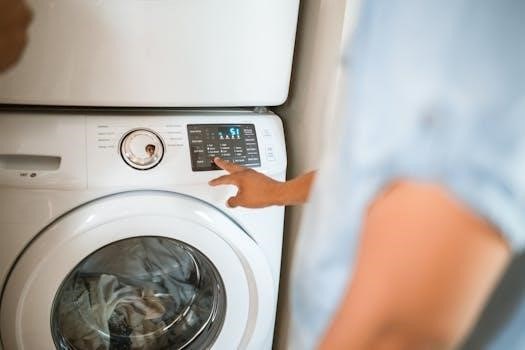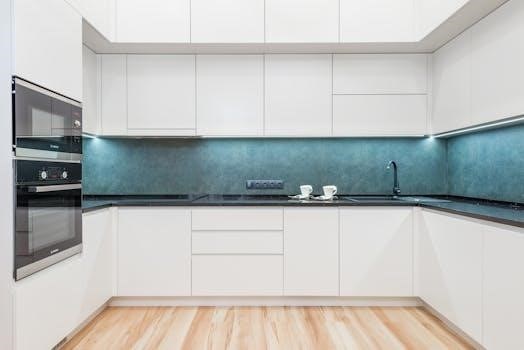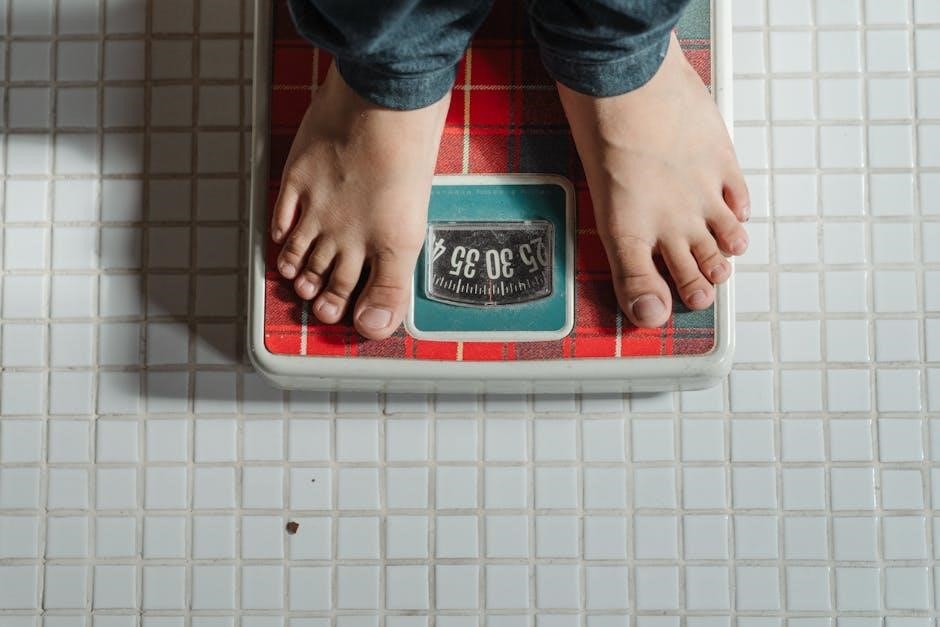bosch self cleaning oven instructions
Bosch Self-Cleaning Oven⁚ An Overview
Bosch pyrolytic ovens offer a convenient self-cleaning feature, eliminating the need for manual scrubbing. These ovens use high temperatures to turn food residue into ash, which can then be easily wiped away. This process provides an efficient and environmentally friendly solution.
Understanding Pyrolytic Self-Cleaning
Pyrolytic self-cleaning is a process utilized by Bosch ovens to simplify maintenance. This method involves heating the oven to extremely high temperatures, typically ranging from 800 to 900 degrees Fahrenheit (approximately 480 degrees Celsius). The intense heat effectively incinerates food debris and grease, reducing them to a fine ash residue. This ash can be easily wiped away once the oven has cooled down. This process eliminates the need for harsh chemicals or manual scrubbing, providing a convenient and efficient way to clean the oven interior. The pyrolytic function offers a hands-free approach to maintaining a clean oven, enhancing user convenience and saving time and effort.
How the Self-Cleaning Cycle Works
The self-cleaning cycle in a Bosch oven initiates by heating the oven cavity to an extremely high temperature, typically reaching between 800 and 900 degrees Fahrenheit. This intense heat breaks down accumulated food residue, grease, and spills into ash. The oven door automatically locks for safety during the cycle. The duration of the cycle can vary, generally lasting one to three hours, but some cycles may extend up to six hours. Once the cleaning process is complete and the oven has cooled sufficiently, the door unlocks, allowing users to easily wipe away the remaining ash residue. This method ensures a thorough and hands-free cleaning of the oven interior.
Preparation Before Self-Cleaning
Before initiating the self-cleaning cycle, it’s essential to remove all racks and accessories from the oven. Additionally, manual cleaning of specific areas may be necessary.
Removing Racks and Accessories
Prior to starting the self-cleaning cycle on your Bosch oven, it is crucial to remove all oven racks and any other accessories. These items are not designed to withstand the extreme temperatures of the pyrolytic cleaning process, which can reach up to 900 degrees Fahrenheit. Failure to remove these items could result in damage or warping. Additionally, any remaining food particles on the racks or accessories can potentially create smoke or unpleasant odors during the cleaning cycle. Thus, it is essential to empty the oven completely before activating self-clean. Ensure that all pans, baking sheets, and any other removable components are taken out and set aside. This preparatory step is key to a successful and safe self-cleaning operation.
Manual Cleaning of Specific Areas
Before activating the self-cleaning cycle, it’s important to manually clean specific areas of your Bosch oven. The high temperatures during self-clean may not effectively remove all soil, particularly around the door edge, window, oven front frame, and cavity edges. These areas don’t get hot enough for residue to burn away completely. Utilize a soft cloth and warm, soapy water to wipe down these regions. For stubborn spots, consider a specialized oven cleaner, but avoid harsh chemicals. Pre-cleaning these areas will ensure a more thorough overall cleaning outcome and prevent any residue from baking onto these specific parts during the self-clean cycle. Removing grease or liquid spills is also essential to prevent smoke.

Activating the Self-Cleaning Cycle
To start the self-cleaning cycle on a Bosch oven, press and hold the BAKE and BROIL buttons simultaneously. Then, select the START button after “SELF CLEAN” appears on the display.
Steps to Initiate Self-Clean
To begin the self-cleaning process on your Bosch oven, first, ensure that the oven is completely empty, removing all racks, pans, and accessories. Then, locate the control panel, where you’ll typically find the BAKE and BROIL buttons. Simultaneously press and hold both the BAKE and BROIL buttons until the phrase “SELF CLEAN” appears on the oven’s display. Once this is visible, press the START button to initiate the cleaning cycle. The oven door will automatically lock and the self-clean cycle will begin. Note that, the default cleaning time is set to four hours, but some models may offer adjustments.
Default Cleaning Time and Settings
Bosch self-cleaning ovens typically have a default cleaning cycle time of approximately four hours. This duration is set to effectively burn off food residue and grime accumulated inside the oven. However, the specific time may vary slightly depending on the oven model and the level of soiling. Some Bosch ovens may offer options to adjust the cleaning time or select different levels of cleaning intensity. While the default setting is generally suitable for most cleaning needs, check your oven’s manual to determine the adjustable options available. It’s essential to understand the default settings to optimize the cleaning cycle.

Safety Features and Considerations
Bosch ovens include a door locking mechanism during self-cleaning, ensuring safety. The process produces potential fumes, so proper ventilation is important. These features are crucial for safe operation.
Oven Door Locking Mechanism
Bosch self-cleaning ovens are equipped with a crucial safety feature⁚ an automatic door locking mechanism. This system engages once the self-cleaning cycle is initiated, ensuring that the oven door remains securely closed throughout the high-temperature process. The lock prevents accidental opening during the cleaning cycle, which could expose users to extremely hot temperatures and potential burns. This mechanism is designed to remain engaged until the oven has cooled down sufficiently, at which point it will automatically unlock. A sensor checks if the door is completely closed before the cycle begins; if not, the self-cleaning process will not start. This dual-safety system ensures user protection by preventing access to the hot interior during the cleaning.
Potential for Noxious Fumes
During the self-cleaning cycle, Bosch ovens reach extremely high temperatures, which can produce strong and potentially noxious fumes. These fumes are a result of the intense heat breaking down food residues and splatters into ash. It’s crucial to ensure that the kitchen is well-ventilated when operating the self-cleaning feature, either by opening windows or using an exhaust fan. These fumes are typically harmless, but can be irritating to some individuals, particularly those with respiratory sensitivities. It’s advisable to keep children and pets away from the kitchen area while the self-cleaning cycle is in progress to minimize any potential discomfort or exposure to these fumes. Proper ventilation will help to dissipate the fumes quickly and safely.

Post Self-Cleaning Procedures
After the self-cleaning cycle completes, allow the oven to cool down. Once cooled, wipe away any remaining ash residue with a damp cloth. The door will unlock automatically after cooling.
Cooling Down and Door Unlocking
Following the completion of the self-cleaning cycle, it’s crucial to allow the Bosch oven to cool down completely before attempting to access the interior. The oven’s door will remain locked during the high-temperature cleaning process and will not unlock until the internal temperature has dropped to a safe level. This safety mechanism is designed to prevent accidental burns. The cooling period can vary, but it’s essential to be patient and wait for the oven to indicate that it’s safe to open. Attempting to force the door open before it’s unlocked could cause damage to the oven’s locking mechanism. Once the oven has sufficiently cooled, the door will unlock automatically, signaling that it’s safe to proceed with the next step of removing any ash residue.
Wiping Away Ash Residue
After the Bosch oven’s self-cleaning cycle concludes and the door unlocks, the next step involves addressing the ash residue. This fine, powdery substance is the byproduct of the high-temperature cleaning process, where food debris is reduced to ash. Using a damp cloth or sponge, carefully wipe down the interior surfaces of the oven. Pay close attention to the walls, floor, and door of the oven, ensuring all ash is removed. Avoid using abrasive cleaners or scouring pads, as these can damage the oven’s interior. This process will complete the self-cleaning cycle, leaving your Bosch oven clean and ready for future use. A simple wipe-down is typically all that’s required to remove the ash.

Troubleshooting and Maintenance
If your Bosch oven fails to start the self-clean cycle, try resetting by unplugging it for ten minutes. Regular maintenance is crucial for its performance and longevity.
Oven Not Initiating Self-Clean
If your Bosch oven is not initiating the self-cleaning cycle, several factors could be responsible. Firstly, ensure that the oven door is completely closed, as Bosch ovens have a safety switch that prevents the cycle from starting if the door is not properly shut. If the door is closed correctly, try resetting the oven by unplugging it from the power source for approximately ten minutes, which might resolve any temporary electronic glitches preventing the self-clean cycle from starting. Additionally, check for any error codes that might be displayed on the oven’s control panel and consult the user manual for troubleshooting steps. Liquid or greasy spots must be cleaned before using self-clean. If the problem persists, further professional assistance might be needed.
Importance of Regular Maintenance
Regular maintenance of your Bosch self-cleaning oven is crucial for ensuring its longevity and optimal performance. While the self-cleaning cycle effectively removes baked-on residue, it’s important to manually clean the oven door edge, window, front frame, and cavity edges, as these areas might not reach high enough temperatures for soil to burn away during the cycle. Additionally, cleaning up liquid or greasy spills before using the self-clean function can prevent potential issues. Regularly wiping down surfaces with warm, soapy water and a soft cloth can also help to prevent buildup and maintain the oven’s appearance and function. This routine care ensures that your oven remains in top condition and continues to perform efficiently, thereby extending its lifespan.












Leave a Comment